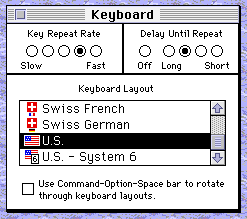Keyboard/mouse
Keyboard
For non-ADB Macintosh models (128K, 512K, 512Ke and Plus), Snow emulates the Apple M0110 keyboard with the following layout:
,---------------------------------------------------------.
| `| 1| 2| 3| 4| 5| 6| 7| 8| 9| 0| -| =|Backs|
|---------------------------------------------------------|
|Tab | Q| W| E| R| T| Y| U| I| O| P| [| ]| \|
|---------------------------------------------------------|
|CapsLo| A| S| D| F| G| H| J| K| L| ;| '|Return|
|---------------------------------------------------------|
|Shift | Z| X| C| V| B| N| M| ,| .| /| |
`---------------------------------------------------------'
|Opt|Mac | Space |Enter|Opt|
`------------------------------------------------'
For Macintosh models with ADB, Snow emulates the Apple extended keyboard M0115 with the following "U.S. Domestic" layout:
,---. .---------------. ,---------------. ,---------------. ,-----------. ,---.
|Esc| |F1 |F2 |F3 |F4 | |F5 |F6 |F7 |F8 | |F9 |F10|F11|F12| |PrS|ScL|Pau| |Pwr|
`---' `---------------' `---------------' `---------------' `-----------' `---'
,-----------------------------------------------------------. ,-----------. ,---------------.
| `| 1| 2| 3| 4| 5| 6| 7| 8| 9| 0| -| =|Backspa| |Ins|Hom|PgU| |NmL| =| /| *|
|-----------------------------------------------------------| |-----------| |---------------|
|Tab | Q| W| E| R| T| Y| U| I| O| P| [| ]| \ | |Del|End|PgD| | 7| 8| 9| -|
|-----------------------------------------------------------| `-----------' |---------------|
|CapsLo| A| S| D| F| G| H| J| K| L| ;| '| Return| | 4| 5| 6| +|
|-----------------------------------------------------------| ,---. |---------------|
|Shift | Z| X| C| V| B| N| M| ,| ,| /|Shift | |Up | | 1| 2| 3| |
|-----------------------------------------------------------| ,-----------. |-----------|Ent|
|Ctrl |Opt | Cmd | Space | Cmd |Opt |Ctrl | |Lef|Dow|Rig| | 0| .| |
`-----------------------------------------------------------' `-----------' `---------------'
These are currently the only keyboard layouts supported. If you experience issues with incorrect key presses inside the emulated system, particularly with localized operating systems, change the keyboard layout to "U.S." or "U.S. Domestic" (Apple menu > Control Panel > Keyboard).

Command key
To use the Command key on a MacOS host, you can simply use the Command button on the host system.
On Windows and Linux hosts, you can use the right ALT key. The 'Super' key (the Windows key) is also mapped to the Command key, but this key is often not forwarded by the operating system. On Windows, you can use SHIFT+WIN to press the Command key, but since this is rather inconvenient, Snow provides the right ALT as an alternative.
To enable or disable mapping the right ALT to Command, use the menu item 'Options > Map right ALT to Cmd'. This option is saved in the workspace.
Mouse
Snow supports two ways of emulating the mouse, which can be chosen under 'Advanced' in the Load ROM dialog.
Absolute positioning (default)
Absolute mouse positioning to provide an intuitive way of using the mouse. Moving the mouse cursor over the display of the emulated system will move the mouse on the emulated system. When entering the edge of display, the cursor will immediately jump to that location. The speed of the mouse matches that of the host system.
To achieve this, Snow patches a couple of global variables in the memory of the Mac. This makes this mode unsuited for certain games and non-original operating systems and ROMs.
Relative positioning / hardware mouse emulation
This mode emulates the Macintosh mouse on the lowest level, but since hardware mice only signal relative movement to the computer, it only passes relative movements to the emulated system. This may make it harder to control the mouse, but it provides the most accurate emulation experience and works best with some games (e.g. first person shooters) and non-original software.
Relative positioning mode works best when using Snow fullscreen.